SPRINGFIELDMASSACHUSETTS |
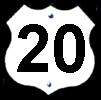 |
SPRINGFIELDMASSACHUSETTS |
 |
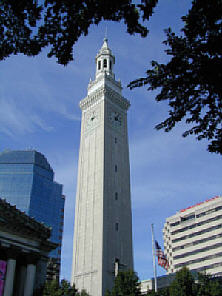 Springfield was a crossroad many times during the Revolutionary War:
Springfield was a crossroad many times during the Revolutionary War:
Court Square -A witness to all these events sits atop Old First Church on the west side of
Court Square. As indicated by a marker near the church, the rooster has been
indicating wind direction to the people below since 1750.
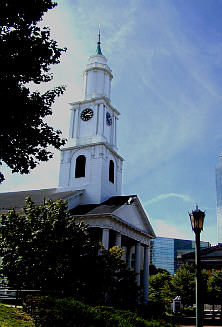 |
Old First Church has been located in Court Square since the 17th century. It was the twentieth parish formed in the Massachusetts Bay Colony, and was gathered in 1637, the year after Springfield was founded. The first meetinghouse was erected just east of this site in 1645. This meetinghouse is the fourth building on this site, built in 1819 by a Northampton man, Isaac Damon. The rooster weathervane on the steeple was crafted by a London Coppersmith, and brought to this country in 1750. The Congregation welcomes you to its worship and work. (Springfield Marker) |
On the south side of Court Square is where Washington was entertained when he passed through Springfield. A marker now stands at the former location of Parsons Tavern.
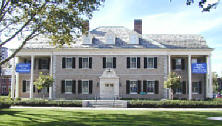 Connecticut
Valley Historical Museum - About a block south and two blocks east on State Street is the Springfield
Library. The library parking lot is on the south side of State Street. Behind
the library is the Connecticut Valley Historical Museum. The museum focuses on
the history and culture of the valley since 1636. The architecture of the
building is 18th century, Colonial revival.
Connecticut
Valley Historical Museum - About a block south and two blocks east on State Street is the Springfield
Library. The library parking lot is on the south side of State Street. Behind
the library is the Connecticut Valley Historical Museum. The museum focuses on
the history and culture of the valley since 1636. The architecture of the
building is 18th century, Colonial revival.
Also behind the museum is the Dr. Seuss National Memorial. Springfield is the hometown of Ted Geisel (Dr. Seuss). One may wonder what the author of Cat in the Hat, Green Eggs and Ham and The Grinch Who Stole Christmas has to do with a Revolutionary War road trip, but the engraved Dr. Seuss story about travel and discovery at the national memorial does. It is a very motivating story.
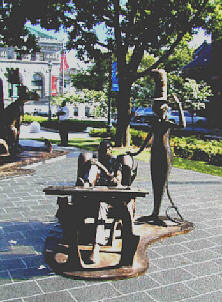 |
Congratulations! Today is your day. You’re off to Great Places! You’re off and away! You have brains in your head. You have feet in your shoes. You can steer yourself any direction you choose. You’re on your own. And you know what you know. And YOU are the guy who’ll decide where to go... (Dr. Seuss Exhibit) |
Springfield Armory - About three blocks past the library is the Springfield Armory. However, the entrance to the armory is about a mile from the library on Federal Street, a left turn off State Street. There are several markers near the entrance to the armory. Inside, there are directional signs to the Armory Museum. A visit to the museum is recommended. Today, most of the armory is used by Springfield Technical Community College.
General George Washington and Colonel Henry Knox chose this hill above the Connecticut River as the site of the first United States arsenal. Although Springfield was still only a small, struggling village, its geographic advantages were obvious. The town was located at the intersection of colonial highways and the Connecticut River but far enough upstream to be safe from enemy attack. Supplies were all close at hand. Knox concluded that “the plain just above Springfield is perhaps one of the most proper spots on every account” for the location of an arsenal.
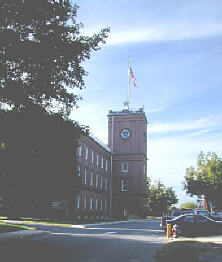 |
UNITED STATES ARMORY During the War of Independence, an arsenal on this site provided supplies and equipment for the American forces. On the recommendations of George Washington, Congress formally established the Springfield Armory in 1794. Until its closing in 1968, the Armory developed and produced most of the small arms which served American soldiers in the nation’s wars. Its presence also set Springfield on the path of industrial growth. The 55 acres within the ornamental cast-iron fence are now administered by Springfield Technical Community College and the National Park Service. Most of the buildings were erected during the nineteenth century, with the oldest dating from 1808. The complex reflects the Armory commanders’ goal of creating an institution with dignity and architectural integrity worthy of the increasing strength of the federal government. (Armory Marker) |
During the Revolution, the arsenal stored muskets, cannons, and other weapons and produced paper cartridges. Barracks, shops, storehouses, and a magazine were built, but no arms were manufactured. After the war the government kept the facility to store arms for future needs.
Just outside the armory, about a block east of Federal Street and on State Street was the site of the battle for the armory during Shays’ Rebellion. The rebels, numbering about 2,500 soldiers, planned a three-pronged attack on January 25, 1787. Luke Day would lead the attack from the west, Eli Parson from the north and Daniel Shays from the east.
Major General William Shepard, who received advance word of the attack, gathered a force of about 1,200 soldiers from the Massachusetts Militia to defend the armory. At the time, the armory contained several large cannons and a howitzer, thousands of muskets, hundreds of barrels of powder as well as tons of shots and shells. The thought of this armory in the hands of the rebels was clearly on the mind of General Shepard. The same thought would have a revolutionary effect on Congress.
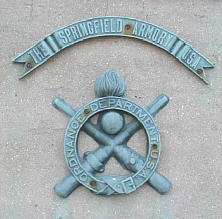 Just before the scheduled attack, Luke Day decided to change the plans. He
sent a note to Eli Parsons and Daniel Shays to delay the attack until January
26th. He sent a note to General Shepard demanding surrender of the armory within
twenty-four hours. Unfortunately for Luke Day, the notes to Parsons and Shays
were intercepted by Shepard.
Just before the scheduled attack, Luke Day decided to change the plans. He
sent a note to Eli Parsons and Daniel Shays to delay the attack until January
26th. He sent a note to General Shepard demanding surrender of the armory within
twenty-four hours. Unfortunately for Luke Day, the notes to Parsons and Shays
were intercepted by Shepard.
On the afternoon of January 25th, Parsons and Shays regiments, not knowing about the change in plans, began their attack on the armory. The advance guard marched toward the armory with a frontal, shoulder-to-shoulder, assault. Shepard first fired his cannons over the heads of the attackers. The effect of the firing did not stem the frontal assault of the veteran rebels of the advance guard. However, Daniel Shays’ mounted soldiers in the rear, who were closer to the receiving end of the cannons, did respond. They retreated in a panic.
The advance guard continued their march until they were sprayed with grapeshot from a Howitzer leveled for direct fire at the rebels. The advance guard retreated after they realized they were without any support from the rear. They left behind four killed and several wounded.
After the battle in Springfield, the rebels were chased by General Benjamin Lincoln to the north. Most of the rebels abandoned the fight and returned to their farms. Daniel Shays eventually retreated to Vermont, which at the time was an independent republic. Except for a few small skirmishes and the last battle near Great Barrington, Shays’ Rebellion gradually faded away.
The effect of Shays’ Rebellion, however, did not. The thought of a rebel force taking over the state of Massachusetts, which might have succeeded given the munitions at the Springfield Armory, forced Congress to move on the adoption of a constitution for the United States. The constitution would define a strong central government with an army that could be raised to respond to uprisings in the states.
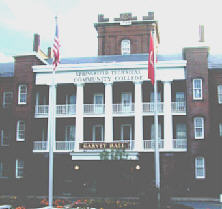 On May 25, 1787, General Henry Knox, the Secretary of War, addressed the
Constitutional Convention in Philadelphia: “The commotion of Massachusetts
have wrought prodigious changes in the minds of men in the State respecting the
Powers of Government...they must be strengthened, there is no security of
liberty or property.”
On May 25, 1787, General Henry Knox, the Secretary of War, addressed the
Constitutional Convention in Philadelphia: “The commotion of Massachusetts
have wrought prodigious changes in the minds of men in the State respecting the
Powers of Government...they must be strengthened, there is no security of
liberty or property.”
It was Shays’ Rebellion that put the final pieces in place to form the government of the United States — a true end to the Revolutionary War.
After the battle at the armory, the new Federal government in 1794 decided to manufacture its own muskets so that the nation would not be dependent on foreign arms. President Washington selected Springfield as the site of one of the two Federal armories. New buildings were erected and the armory was expanded.
The West Armory, the oldest surviving building, was completed in 1808 and the Main Armory Building, in 1847. By then the armory grounds had taken on an orderly, symmetrical appearance that in part remains today. Around a landscaped green there were clustered storage building, blacksmith shops, and administrative offices. The attractive setting encouraged the development of fine residential neighborhoods in the vicinity.
It was here that the famous 1873 “Trapdoor” Springfield Rifle, the Model 1903 of World War I, and the M-1 Garand were made. The M-1 was known to millions of servicemen in World War II and the Korean War.Stuff here.
Shays' Rebellion Marker --
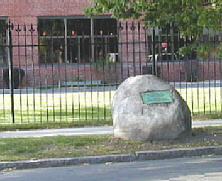 |
This tablet marks the battle place of
Shays’ Rebellion, January 25, 1787.
Erected by the George Washington Chapter Sons of the American Revolution, AD 1900 (Springfield Marker) |
